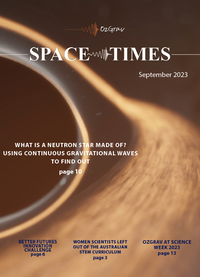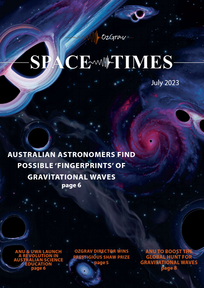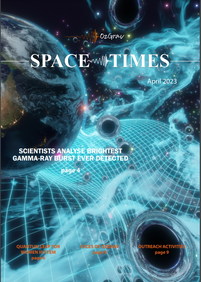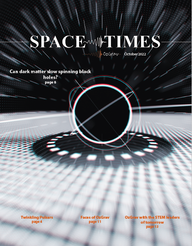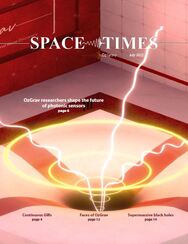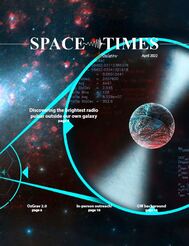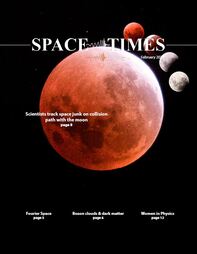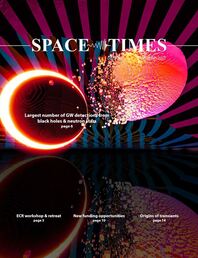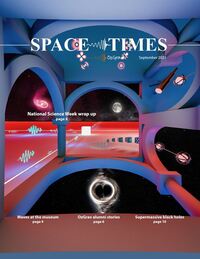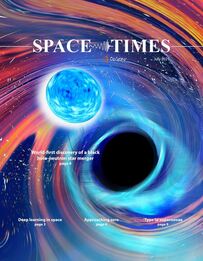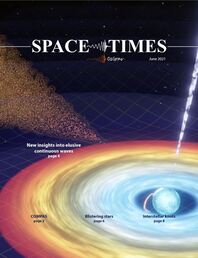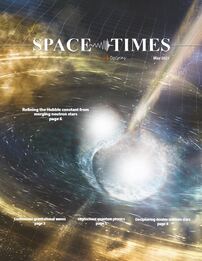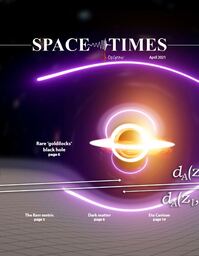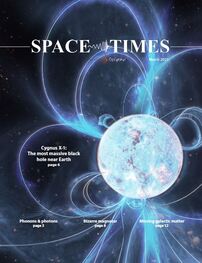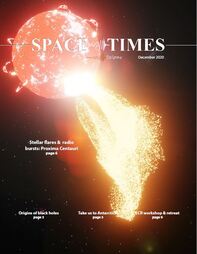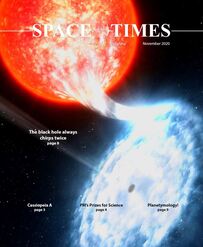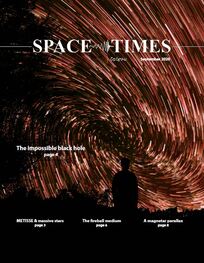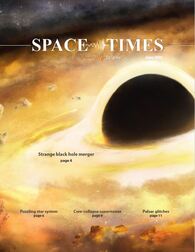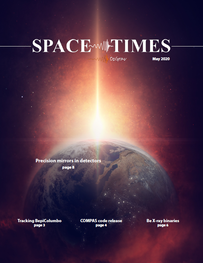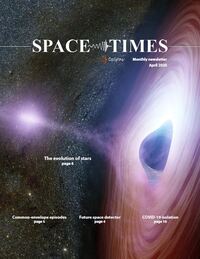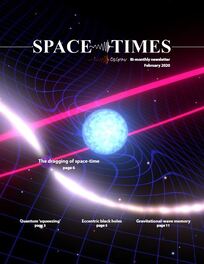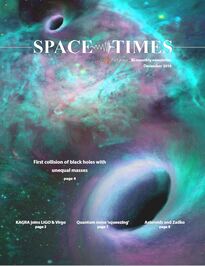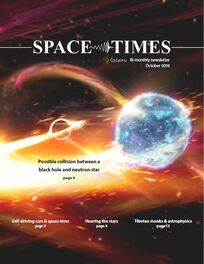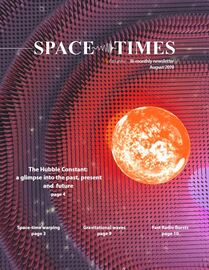|
September 2023
There has been considerable activity within the Centre in recent months, including our involvement in a brand-new initiatives and events! On this issue, we address an important topic – women's representation in the Australian STEM curriculum. Our members' research in this area highlights the need for increased inclusivity and recognition of women scientists. On that topic, I am delighted to congratulate two of our rising star researchers, Lilli Sun and Shivani Bhandari, who received ARC DECRA awards for their exceptional research contributions. This is a testament to their talent and hard work, and the high impact of our field of research. I am also proud of OzGrav students' achievements at the Annual Scientific Meeting of the ASA, where they featured prominently in the line-up of prize winners for posters and talks. Lastly, I look forward to welcoming all our members in Adelaide for this important annual gathering, where we will reflect on our achievements over the past seven years. July 2023
As OzGrav's first 7 years of funding are ending, we've had some remarkable successes in recent weeks that I'm confident would not be taking place without funding for the Centre. Firstly, OzGrav staff, students and technicians helped prepare the Advanced LIGO interferometers for the long-awaited 4th observing run "O4". Just last week I had an excited postdoc appear at my door wanting to show me one of LIGO's highest significance black hole mergers which was a joy to behold. Last week also saw the worldwide release of the pulsar timing array searches for gravitational waves from supermassive black hole binaries in the distant universe. Many OzGrav staff are members of the Parkes Pulsar Timing Array collaboration, and it was one of four groups seeing hints of the gravitational wave background that you can read about in this newsletter. I'd describe the results as tantalising! I hope you enjoy July's issue of Space Times. April 2023
There's a lot of excitement at OzGrav. We are now only one month away from the LIGO-Virgo-Kagra's fourth major observing run "O4" ; we had the fantastic news that our Indian colleagues have secured (very significant) construction funding for the 4km LIGO-India - the fifth detector in the Northern hemisphere(!) - and momentum is building for the so-called 3G detectors in both Europe and the US. Many of us in OzGrav are exploring the possible role Australia will play in the 3G detector landscape in the coming years and are planning both national and international workshops to be hosted here. For the time being, I hope you enjoy this issue of Space Times, which has a particular emphasis on our Outreach activities and talks about the analysis of one of brightest gamma-ray burst ever detected. January 2023
Welcome to the first 2023 issue of Space Times! This year we start with possitive news and great resolutions. Late last year we had the fantastic news that the Australian Research Council had concluded its selection processes and that OzGrav was to be funded for another 7 years! This achievement is both a testament to the staff, students and admin that helped build OzGrav’s national and international reputation in its first seven years and the team that put together the 2023 bid. The new Centre will be pursuing six major Key Projects, and we will be joined by new university research centres. We are all looking foward to the changes ahead. In the meantime, I hope you enjoy this issue of Space Times and read about the successes of our many staff and students. October 2022
Welcome to another issue of Space Times! Closer to home OzGrav concluded the competitive processes for a second 7-year investment in gravitational wave science, the results of which should be known in early November. We nervously wait for the outcomes and hope that Australia can maintain its strong position in GW astrophysics. In this issue, you can also read about OzGrav’s ARC bid, twinkling pulsars, black holes, the Gingin GW precinct, outreach and meet ANU’s Professor Susan Scott, an OzGrav Chief Investigator. We hope you enjoy reading this edition! July 2022
This month we’re preparing for the final part of the selection process for the 2023 ARC Centres of Excellence in which OzGrav was fortunate enough to join 16 other potential centres for support from 2023-2030. Our intrepid 6-person interview team will be grilled for an hour in early August about the exciting science we’d pursue if selected. In this issue, you can read about our members’ recent achievements, including searches for X-ray pulsations from neutron stars, OzGravvers commercialising technology for autonomous navigation, a new light projection exhibition, and your Director’s appointment as a Fellow of the AAS. April 2022
I've been coming up for air after submitting a full application for another Centre of Excellence focussed on gravitational waves that would start next year if successful. The Centres represent one of the best value-for-money investments of the Australian Research Council and I'm very confident that the community has put forward the best possible case for continued funding. We hope you enjoy reading this edition packed with new research highlights and discoveries! |
|
February 2022
Welcome to first 2022 edition of Space Times! In this issue you’ll see how the remarkable double pulsar system is rewriting the records on tests of General Relativity, how gravitational wave research is opening new insights into everything from supermassive black hole binaries to more exotic explanations of dark matter via boson clouds and the evolution of binary and clusters of stars. Finally, two of our recently-alumni members have created a novel colouring book that features important women in physics. Buy one! December 2021
Welcome to the final edition of Space Times for 2021! The pandemic has delivered very different experiences for our members depending upon their geographical location. Overall our staff and members have remained very productive despite the lockdowns, and last week OzGrav had its second virtual annual retreat, followed by local social events in our four node cities. Since the first gravitational wave detection in 2015, the growth in gravitational wave astrophysics has been remarkable with the number of detections now at 90, all thanks to the hard work of a large international team including many of our OzGrav team. O4 (the fourth observing run starting late 2022) promises to yield the most detections yet and should help OzGrav complete its seven-year mission with new exciting science. We wish you all a refreshing break in the Christmas/New year holiday period. |
|
September 2021
In this issue we feature OzGrav Alumni Qi Chu and Joshua McCann as they begin their careers in industry after successful postdoctoral and PhD positions at UWA, and highlight some of our innovative outreach underway. As I type this message, my 2-year-old grand-daughter (who now lives with us) is singing downstairs, the sun is shining on a cool Melbourne Spring day, and I'm preparing for another day of Zoom meetings after a morning ride and coffee at the local Italian-run shop that has been doing a roaring trade since the lockdowns began. Despite the lockdown restrictions, many of our staff and students continue to make good progress, find jobs and enjoy little things that give us cause for celebration. |
|
July 2021
Despite the latest round of lockdowns (groan) we’ve had some great outcomes since our last newsletter. Firstly, OzGrav received its official feedback from the mid-term review which was incredibly positive. Secondly, OzGrav ran a very successful online international conference “Amaldi 14” last week. And finally, after an 8-month process led by Prof Tamara Davis, I was elected to lead a second OzGrav ARC Centre bid and we submitted the 100-page expression of interest last Wednesday. On top of conferences and the bureaucracy that keeps OzGrav functioning, there’s been some great science happening that you can read about in this issue. June 2021
This year OzGrav is the lead institution for the 14th Amaldi conference on gravitational waves. We’ve been busy processing applications, reviewing abstracts with an international scientific organising committee, and trying to ensure the international community stays connected. We’ve also just received the welcome news that OzGrav won a Silver Pleides award for our efforts to improve Equity and Diversity in the Centre. I’m indebted to our very active E&D committee and to everyone in OzGrav for their efforts that led to this success. |
|
May 2021
OzGrav has now had its fourth birthday and many of us were interviewed as a part of the ARC's mid-term review process. I was really proud to get the positive verbal feedback from the review panel and look forward to their official recommendations. The Gravitational Waves discipline is very young in terms of detections but has a 100-year history in many respects. With the help of Professor Tamara Davis, OzGrav has been running a series of national workshops and seeking white papers for projects that could form part of a second Centre of Excellence, with gravitational waves as a focus. I hope you enjoy hearing about our current science and meeting some of our personnel. |
|
April 2021
One of my main duties as Director over the past six months has been organising the documentation, presentations and interviews for the Australian Research Council’s mid term review of OzGrav which occurred in early April. As I was thumbing through the annual reports, one image particularly struck me as exemplifying the essence of OzGrav. It pictures one of our Monash PhD students and the partner of another (from Swinburne) volunteering their time to show members of the public the wonderful science of neutron stars, black holes and gravitational waves about which we’re all so passionate. I find such images extremely uplifting, and this one in particular energized me prior to the Director’s presentation to the review committee. I couldn’t have been happier with how the review went and wanted to thank everyone in OzGrav for making the review process a joy, especially Yeshe’s admin team who organised it all and made it go like clockwork. March 2021
Welcome to the first 2021 edition of Space Times. In the next few weeks OzGrav will be presenting its achievements to the Australian Research Council's mid-term review panel, formulating a bid for an OzGrav 2.0. I'm confident we’ll be proud of our efforts and fantastic research outcomes as illustrated in the articles of every OzGrav newsletter. I also want to take this opportunity to congratulate Professor David McClelland for his career achievement award (The Thomas Ranken Lyle medal) from the Australian Academy of Sciences announced recently. I hope you enjoy this issue of Space Times and that I’ll see you all soon, not just on zoom |
|
December 2020
Finally 2020 draws to a close and it has been a year unlike any other! We started the year with horrific bushfires significantly impacting our colleagues in NSW and the ACT before the world was hit by COVID-19. Despite the lockdowns, many determined OzGravvers have continued to be very scientifically productive and you can read about some of their achievements, prizes and dreams in this issue. Have a great holiday break over the Christmas period, you all deserve it! I know I am personally really looking forward to a break, and hope that with the rollout of vaccines we’ll soon return to our pre-COVID lives. |
|
November 2020
No matter where you are in the world there’s no doubt that 2020 has been a long year. For the three OzGrav nodes in Melbourne this has been especially so with two lockdowns in seven months, and little physical contact with our friends, colleagues and families. It is hard to describe the joy that easing of restrictions brings after hanging on the daily case numbers for what seems like an eternity. Collectively our staff have been remarkably productive during lockdown, and as you’ll see in this issue, pursuing some great science. But if my own emotions are anything to go by, it would be incredibly surprising if many of our staff and students haven’t found the year very challenging, and we’re constantly looking at how OzGrav can assist our members facing uncertain times in the academic sector. |
|
September 2020 A special note to our Victorian-based members who have now been in one form of lockdown or restriction for the past 6 months. Most of us are well fed, have a roof over our head, and plenty of work to do. This doesn't make it an easy time though, and it is hard not to miss the freedoms that we have given up in order to suppress the virus. Let's hope that the case numbers keep falling and that Australia is soon on top of the second wave. This month, we cover fantastic research led and co-authored by our members, including the first ever monster intermediate black hole directly observed, and congratulate our OzGravver's on their recent achievements, such as winning the 3-minute thesis finals! |
|
August 2020
Despite these challenging times, especially for Victorians who are currently under Stage 4 lockdown, we are thrilled to see that, once again, OzGrav research has featured on the cover of the Australian Research Council’s annual magazine and that many of our determined researchers remain scientifically productive. |
|
July 2020
It's been a tough month, especially for those under lockdown again in Melbourne; however, the OzGrav community continues to make fantastic progress in their research efforts. This month the Centre was scheduled to have its mid-term review and it’s very reassuring to see so many of the OzGrav scientists and admin staff producing excellent work as featured in this newsletter. We're also delighted that gravitational waves are now a bona fide part of Australia’s astronomical research as featured in the Decadal plan’s mid-term review. |
|
June 2020 We are thrilled that our Governance Advisory Committee member Tamara Davis (now AM!!) made a member of the Queen’s Birthday Honours list, and PhD student Carolyn Maxwell won the Educator’s prize at the University of Western Australia. We hope you enjoy reading this edition of Space Times, full of new research highlights and stories from our OzGrav community. |
|
May 2020 The OzGrav community continues to achieve good scientific progress despite global adversities, including: the first public release of the COMPAS rapid binary population synthesis code (page 4); a new type of deformable mirror that could improve gravitational-wave detectors (page 8); and the monitoring of space probe BepiColumbo as it leaves Earth on its way to Mercury (page 3). |
|
April 2020 During these chaotic times of COVID-19, we're increasing efforts to stay connected and share our stories in different ways, including through Space Times. We''ll be publishing our newsletter every month from now on (instead of only every two months). In this edition, the spotlight shines on new research from our PhD students and postdocs including insights into the evolution of stars (page 6); common-envelope episodes (page 5); and future space detector LISA (page 4). We also congratulate Adam Deller on receiving the prestigious Pawsey Medal for scientific excellence (page 8) and take a look at what OzGravvers are getting up to in isolation (page 10)—from quilting to to cooking pierogi! |
|
February 2020 In this edition, we cover exciting results on quantum 'squeezing' by OzGrav researchers at Australian National University (page 3); new insights from our PhD students into the eccentricity of black holes (page 5) and gravitational-wave memory (page 11); and the recently published evidence for 'frame dragging'—a spinning celestial body twisting the fabric of space and time (page 6). We also learn more about our impressive members (page 8) and access schemes offered at OzGrav (page 7). |
|
December 2019 In this edition, we report on the upcoming collaboration between Japan’s Kamioka Gravitational-Wave Detector (KAGRA) with the USA’s Laser Interferometer Gravitational-Wave Observatory (LIGO) and Europe’s Virgo (page 3); OzGrav researchers Juan Calderon Bustillo (Monash University) and Meg Millhouse (University of Melbourne) investigate the first collision of black holes with unequal masses (page 4); and OzGrav goes on an expedition to South Africa to commission the MeerKAT radio telescope (page 12). |
|
October 2019 In this edition, we explore the value of OzGrav’s gravitational wave science in improving self-driving cars and learn about the innovative methods of OzGrav’s Jeff Cooke and Garry Foran to hear the stars. We also cover stories about OzGrav Chief Investigator Ilya Mandel’s Tibetan trip teaching astrophysics to monks; the Zadko Observatory in Gingin, Western Australia; and the possible collision between a black hole and neutron star. |
|
August 2019
In this edition of Space Times, Associate Investigator Adam Deller and a team of scientists catch a glimpse into the past, present and future with the measurement of the Hubble Constant; Chief Investigator Jeff Cooke and the the Deeper Wider Faster program reveal more clues about Fast Radio Bursts; and University of Adelaide's 'mini LIGO' dubbed AMIGO demonstrates space-time warping, teaching students of all ages how the Universe works. As the global hunt for gravitational waves continues, OzGrav continues to grow and reach new heights: frequently appearing in the media, collecting prestigious awards and building a strong team. |
|
|


